
FOUNDERS: (Left to right) Alan Rorie, nemo Gould, Christopher T. Palmer, and Jeremy Mayer.
The SMART GALLERY
HOW THE ARTISTS OF OAKLAND’S LOST AND FOUNDRY ARE PAVING THEIR OWN PATH AWAY FROM CONVENTION.
At the end of the 300 block of Center Street in Oakland, Calif., otherwise sparsely lined with drab residential houses, sits the shell of the old Lehnus iron foundry. Once alive with production, times changed and the building sat uninhabited for years. Today, behind the industrial roll-up steel doors and wrought iron fencing lays the unexpected: the beginnings of a powerful paradigm shift in the art world.
Upon entering the Lost and Foundry, you’re greeted by a large, clean, open gallery space, high ceilings accented by massive wood beams. The room is tastefully arranged with a variety of intriguing sculptures made by the seasoned, professional artists who cofounded the collective. One of Jeremy Mayer’s life-sized busts peers forward curiously, made entirely of dry-fit typewriter parts (page 35). To its left, Nemo Gould’s eight-and-a-half-foot tall kinetic sci-fi creature pulses with a Jacob’s ladder in its head. Nearby, Alan Rorie’s mini-submarine-like steel and glass Neuron Chamber (page 39) traces a replica of our neural pathways in electricity. Mounted on one wall, a newly finished interactive piece by Christopher T. Palmer (CTP) illuminates a reel of vintage film (page 32). But unlike most galleries, behind these walls are the studios of the artists whose work is on display.
There’s magic to seeing an artist’s workshop, pieces of a next project beginning to take form, but typically making the art and exhibiting and selling it aren’t done in the same place, or even by the same people. Traditionally, in the professional art world, an artist is represented by a gallery, who offers “four white walls, crackers, boxed wine, and a mailing list of people you never get to interact with,” says Gould. In return, the gallery takes 50% of an artist’s sales. While this standard may have been the best (or only) way for decades, in this age of the internet, the model is shifting. The artists at the Lost and Foundry are out to re-create the gallery model on their own terms, by doing it themselves.
Mayer argues that today, with the pressures to be well represented online, most galleries can’t handle the full social networking needs of the artists they represent. In addition, the face of the new art collector is changing; many of the Lost and Foundry artists’ clients aren’t comfortable in a traditional highbrow gallery setting. The alternative is for artists to create their own collective gallery and represent themselves, combining their networks to grow their clientele.
Seems simple enough, but the resistance to this notion is decades strong. Even the most logical paradigm shift is inherently up against convention and history. Paradoxically, the biggest opponents to artists self-representing are often other artists (some naturally entrenched in galleries) and even traditional art schools that teach that artists make art, while showing and conducting the business of art should be left to the galleries. Gould adds, “Making art is the point. Selling art is the unfortunate secondary aspect, but if you want to afford to do another piece you have to think of a way to make money.”
Until now, artists haven’t coalesced to a point where they can effectively press back against convention and affect change to the system as a whole. But the Lost and Foundry artists propose that if enough artists self-represent, the standard 50% cut that galleries take begins to fade as the norm. Galleries thrive on owning the discourse and the clientele, but are they the best equipped to do it anymore?
And with so much of art representation and sales happening exclusively online, why even have a physical space? Why not buck the gallery as a whole and conduct all business online? That's certainly an option, especially considering the Lost and Foundry artists get a great deal of exposure online, and many of their sales and commissions originate on the internet. But to the members of the collective, as an artist, if you produce and sell exclusively online, you’re up against “a comfortable irrelevance.”
They hold that a work of art is not actually complete until others physically interact with it, and until then it’s missing the vital element of art culture. Gould adds, “Art has to get talked about, and become part of the story of the art and the artist.” And there's no substitute for real-time, physical interaction. Even with the most visually well-documented piece, when viewed exclusively online, details are missed; the web makes things artificially perfect. And perhaps most important to the physical gallery experience is watching someone else react to a work and recognizing yourself in the reaction or not. •
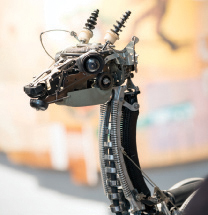
START OF A COLLECTIVE
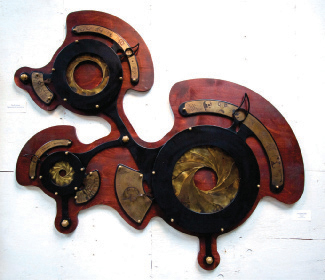
MAYER, GOULD, RORIE, AND PALMER share a lifelong maker mindset and an appreciation for collaboration. Back in 2007, Gould, Palmer, Rorie, and Reuben Margolin exhibited at the second annual Maker Faire Bay Area, under the moniker Applied Kinetic Arts (AKA), a tongue-in-cheek name that originated when they were filling out the entry form. They’ve exhibited at every Bay Area Maker Faire since, joined by Mayer a few years ago, and the way they transform a corner of the Faire into a miniature gallery is always impressive.
Equally notable is the collective’s signature abundance of camaraderie and lack of pretension. Gould said in a 2010 interview, “AKA started out as a way to share the burden of exhibiting at large venues, but it has really evolved into something much more meaningful ... By focusing on the things we have in common it becomes clear that we are all part of something bigger than our individual studios. We have a contemporary art movement on our hands, and by banding together we strengthen our case with the public and the art world at large.”
Then, as fate would have it, roughly two years ago, Mayer met Brad Peik, owner of the old Lehnus foundry building. Having an affinity for old buildings and shops, Peik had purchased the foundry roughly five years prior. Dismayed at how buildings with rich history are so often abandoned or torn down in lieu of box stores, he was interested in honoring the years the structure had housed a workspace where people made things with their hands. Peik was ready to accommodate the right group of artists.
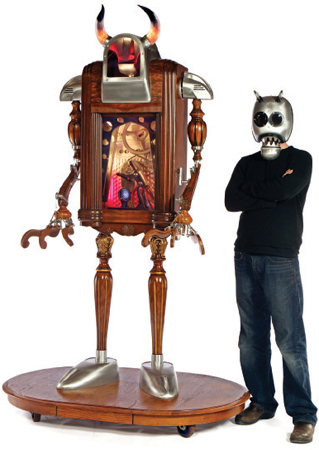
Nemo Gould (Minotaur); Alan Rorie (Triaparator)
IN THE EYE OF THE BEHOLDER: (Clockwise from this page) Nemo Gould’s kinetic Minotaur, pictured with the artist wearing one of his custom masks; Jeremy Mayer’s Deer III typewriter assemblage; Alan Rorie’s Triaparator kinetic brass apertures.
“I WANT THE RIGHT TO MAKE SOMETHING THAT’S TRULY INCONVENIENT TO EVERYONE, WORKS A GALLERY WON’T SHOW.”
Mayer moved his workshop into a mid-sized space to the left of the main room (the gallery). His massive worktable was soon covered in the organized chaos of infinite salvaged typewriter components, surrounded with floor-to-ceiling shelves bearing neatly stacked typewriter carcasses and typewriter cases full of catalogued parts. A big screen often displays an anatomy app, focused on the part of the body he’s working to re-create.
A year later, Gould was looking to move his workshop and decided to join Mayer in the foundry. Because he’s a found-object artist, much of Gould’s time is spent salvaging materials and building his vast stockpile. Moving into the spacious Lost and Foundry allowed him to weed and organize in a logical manner. His studio inhabits a large room to the right of the gallery, full of labeled bins, drawers, and wall-sized shelving bearing all manner of reclaimed materials, large and small. He believes he has more artistic freedom in this type of space: “I want the right to make something that’s truly inconvenient to everyone, works a gallery won’t show.”
When MAKE photo editor Greg Hayes and I first began researching the Lost and Foundry at the end of 2012, only Mayer and Gould had fully established their studios, and the main gallery was a work in progress. By our second visit, Rorie and Palmer had also joined the collective and moved their studios in. Rorie previously had a workshop at St. Louise Studios, an industrial arts space in Oakland. While that space was functional for creating art, it lacked access to a clean, clear space to display and photograph finished pieces, as well as meet with clients and teach private classes. Now Rorie’s studio is set up in the room directly behind the gallery, his full-sized CNC mill front and center, and pieces of his latest custom Voronoi bookshelf waiting to be assembled. Palmer shares Rorie’s workshop as well as the adjacent large shipping container. The enclosed space is perfect for Palmer because much of what he does, in both art and teaching, involves electronics, and his studio has become somewhat of an electronics “clean room” insulated from the sawdust.
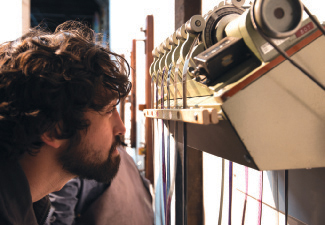
“WE HAVE A CONTEMPORARY ART MOVEMENT ON OUR HANDS, AND BY BANDING TOGETHER WE STRENGTHEN OUR CASE WITH THE PUBLIC AND THE ART WORLD AT LARGE.”
Just as Peik sought artisans who make by hand, the artists were equally drawn to the building’s history, undeniable character, and raw, malleable quality. To work in a building that can be customized to house workspaces, a permanent gallery of finished works, and a professional meeting area is something all the members were seeking. As of this writing, they’ve managed to make it a reality, and are looking to grow it even more. The collective was recently joined by Jeff Hantman, who works primarily in wood and paper, Matt Feeney, creator of Pass & Stow handmade bike racks, and Benjamin Carpenter, interactive artist, fabricator, and teacher. And while all of the artists have a common thread in their works, the selective inclusion of these artists forms a creative harmony, where they all inspire one another and help grow the clientele without turf issues in style.

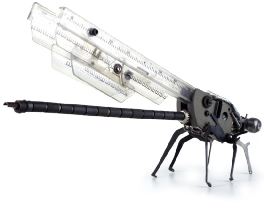
CTP’s Your Lucky Numbers sculpture; Gould’s Honda CX500 Cachet Racer; Mayer’s Mayuko's Damselfly.
Of course, swimming against the stream is never without its challenges. Being represented by a gallery would certainly be easier in a lot of ways, but it would require ignoring the benefits of self-representation. We’ve yet to see if the example they set will ripple out through the art world effecting large-scale change, but if the palpable buzz of the crowd at their first large gallery opening is an indicator, they’re certainly making waves. •
CHRISTOPHER T. PALMER (CTP)

CTP holds the newly salvaged 16mm film synchronizer that he transformed into his Your Lucky Numbers sculpture. Below, his Breatalyzer Genie on display at Roboexotica in Vienna.
Jeremy Mayer (Mayuko's Damselfly); Christian Spanring (Breatalyzer Genie)
ARTIST AND EDUCATOR CHRISTOPHER T. PALMER is rarely called by his full name. Everyone knows him as CTP, and he’s the crowned “Fairy Tech Father” of the collective for the electronics knowledge he brings. As an artist, he most enjoys collaborative work; he’s an active member of Five Ton Crane and has worked with the Flux Foundation and the Flaming Lotus Girls.
Raised in a house full of art and books, CTP was taught early on to value creativity and encouraged to create. His father, now retired, was a machinist and instrument technician, so he was also introduced to machine tools at a young age. With this upbringing, it’s no wonder CTP proficiently straddles art and tech.
Upon finishing his undergrad in photography and visual communication, he launched his own business, CTP Design and Creation, which he’s now had for 23 years. His specialty is “arts engineering,” a term he coined to describe the consulting and fabrication he’s done for other artists. “Since I have my foot in both sides, I can help them realize their vision, without trying to add myself into it, or change it significantly.” While he took commissioned work for years, he generally doesn’t anymore, preferring to teach clients to make it themselves. “If they just want it made and handed over to them, then I’m probably not the guy to come to.”

“I LIKE TO OPEN SOURCE MY BRAIN.”
CTP spent 11 years teaching at Oakland's industrial arts school, The Crucible, heading the Kinetics and Electronics department for a spell. Among the classes he taught were Electronics for Artists, Demystifying the LED, Microcontrollers for Artists, and Kinetic Sculpture. For the past seven years, he’s been on the faculty of the San Francisco Art Institute, teaching three courses: Intro and Intermediate Activating Objects and Active Wearable Objects. He now offers private classes at the Lost and Foundry, teaching intros to soldering, electronics, LEDs, and Arduino, in addition to a class he calls “Beginning Electricity for the Intermediate,” aimed at helping established makers gain a better understanding of electricity.
In his infinite spare time, he’s the Chief Snark Officer at his Snarky McF Button Company, he’s director of technology for a non-profit community service organization, and he’s working on a new book for MAKE titled Make: Machines and Mechanisms. • ctpdesign.com
JEREMY MAYER
SCULPTOR JEREMY MAYER still remembers the first typewriter he typed on, at the young age of 10 in rural Minnesota. He would spend hours peering into his family’s 1920s Underwood #5, imagining himself inside the tiny mechanical city, reminiscent of Fritz Lang’s Metropolis. He also dreamed of disassembling it, but that was not an option.
Mayer began selling his drawings at the age of 14, but it wasn’t until 1994, when he was 22, that he got into making his signature typewriter assemblages. He was living in Fairfield, Iowa, working under a few different artists, doing everything from package design to stained glass to casting anatomical models and Hindu deities, picking up new skills along the way. With no formal art education, Mayer learned strictly by doing.
Then one fated day, he was handed an Olivetti Lettera 32 typewriter and asked to deliver it to the thrift store. Naturally, instead he “scratched a decade-long itch” and took it completely apart, much the same way he does today, sitting cross-legged on the floor with an array of screwdrivers and pliers at the ready. Mayer was struck by how the pieces seemed a perfect blend between his old Erector set parts and the “techno-Baroque” drawings he was doing at the time. His first assemblage was a little dog, which was politely dismissed by the artists he worked with.
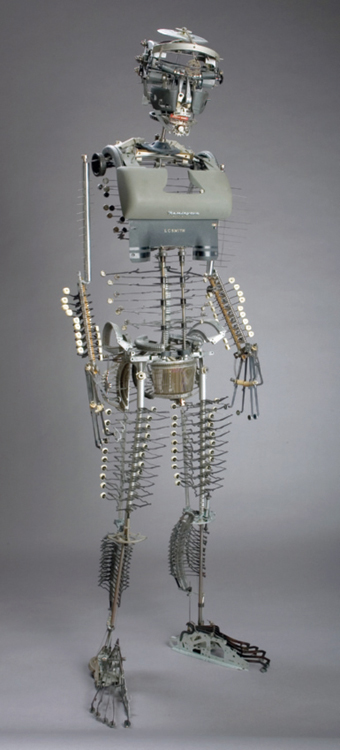
“I DESTROY TYPEWRITERS. I VERY GENTLY KILL THEM UNTIL ALL THAT REMAINS IS A PILE ON THE FLOOR AND A CAST-IRON CARCASS IN MY HANDS. I EVISCERATE THEM.”
Knowing he could do better, Mayer started collecting and disassembling castoff typewriters in earnest. Today, 19 years later, he is a master of his trade, seamlessly assembling typewriter components into amazingly expressive full-sized, anatomically correct human figures, insects, and animals. A diehard purist, he prides himself on a process of entirely cold assembly: no solder, no glue, no welds, no wire, no parts foreign to a typewriter, rules he set for himself early on. An astounding amount of work goes into each piece: Nude IV (Delilah), for instance, took 1,200 hours, contains parts from 40 typewriters, and is 6'4" standing up.
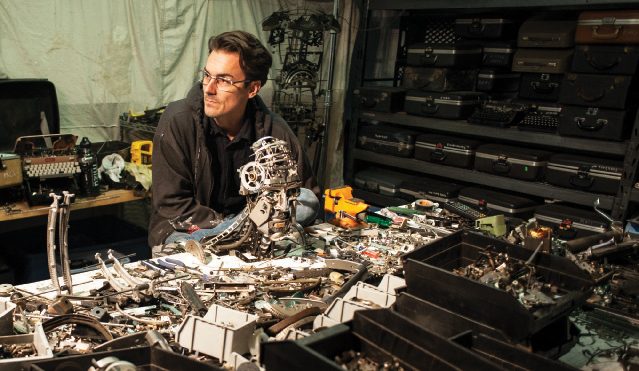
Jeremy Mayer works on a commissioned portrait in his studio. (Below) Bust V (Grandfather), a self portrait; (opposite) Nude is life sized.

Jeremy Mayer (Grandfather); Kate Watts (Nude)
Mayer claims the inherent relationship between typewriters and the human form is what facilitates his art. The width and size of the typewriter were designed to be directly proportional to our anatomy. Further, the look and process of the keys mirrors the process of the fingers that push them. In fact, an intact typewriter looks like a face all by itself, he says: “a menacing creature with a toothy grin.” • jeremymayer.com
NEMO GOULD

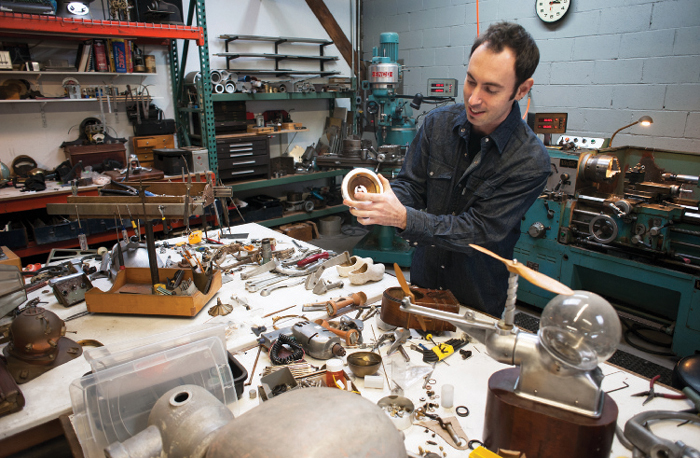
Nemo Gould (all but workshop)
FOUND-OBJECT FINE ARTIST NEMO GOULD professes, “I take silly very seriously.” So seriously, in fact, that a look at his portfolio will deeply challenge any preconceived notion of what art made from salvaged materials can look like. He is a master of creating kinetic sculptures that bear clean, polished lines, exhibit fluid motion, and evoke a genuine, childlike sense of wonder and surprise.
Raised by artist parents, Gould’s creative talents were fostered from a young age. He’s also had a lifelong obsession with collecting and dismantling anything with moving parts and remembers his mother bringing him along on a trip to the dump when he was no older than 7; he told her he wanted to work there when he grew up.
Gould took the unwavering path through a full art education, earning his BFA, then proceeding directly on to an MFA from the University of California Berkeley. In 2000, he was “finally released into the realm of free will” and has been fine-tuning his signature style since, making a living as an independent and internationally recognized artist for the past 13 years. Gould values his MFA program for having taught him discipline through total immersion: 10-hour days in the studio, surrounded by an ecosystem that valued art.
His love of science fiction and comic books first led him to pursue becoming an animator, but when he learned how tedious the work can be, Gould concluded that the challenges of making things move on their own were easier for him to overcome than the patience required to make things seem to move on film, so he began making kinetic sculptures.
Gould spends a lot of time salvaging for materials, with Leatherman, multi-head screwdriver, and Allen wrenches on hand, letting the objects he finds inspire the sculptures he creates. He says, “A ‘found object’ is just a familiar thing seen as though for the first time.” He is the reanimator, seamlessly transforming mundane castoffs into fantastical creatures from a parallel universe. An ordinary old garlic press becomes the animated cosmonaut of a perfectly polished miniature spaceship. “What makes a thing fascinating is to not completely know it,” he says. “It is this gap in our understanding that the imagination uses as its canvas.” • nemogould.com

“I AM ALWAYS TRYING TO MAKE THINGS THAT CAN PRODUCE A CHILDLIKE RESPONSE FROM A JADED ADULT.”

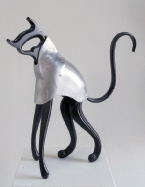

Nemo Gould in his workshop, making magic. The clean lines of Gould’s kinetic works (clockwise from top) In the Forest, Catmonkey, Colonel Ostomy, Little Big Man, and Conganaut defy expections of what found-object art can look like.
ALAN RORIE
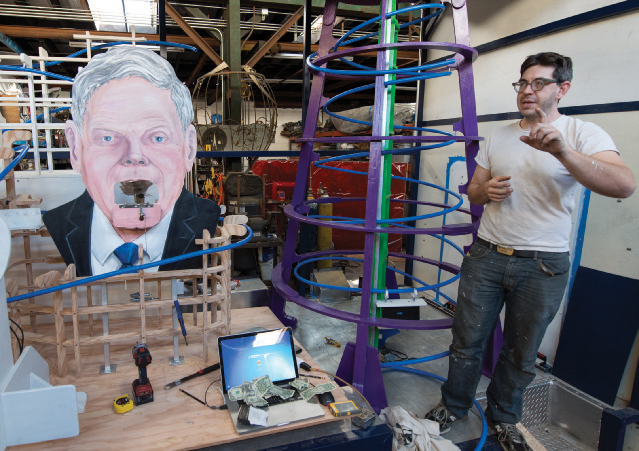
MULTIMEDIA ARTIST AND FABRICATOR ALAN RORIE is not only skilled in a multitude of tools, he also holds a Ph.D. in neuroscience from Stanford. Though he was genuinely passionate about his doctoral research, his dissatisfaction with how abstract and removed from the physical world it was inspired him to delve into making things. Through the Burning Man community, he met Bay Area artists doing amazing metalwork, so with his research grant for tools, he opted to buy welding equipment and slowly taught himself how to weld.
“LESS THINK, MORE BUILD.”
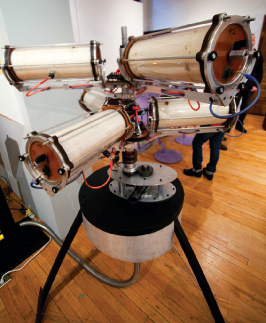
Rorie was instantly drawn to the inherent challenges of kinetic art for its seamless blending of engineering and design. He began collaborating and co-founded Oakland-based art collective Five Ton Crane. His first kinetic piece was a set of three fully functional brass apertures, called The Triaparator (page 30), for the mammoth 40-foot Steampunk Tree House installation. Rorie says that what he learned most from the Ph.D. program is how to discover, observe, and troubleshoot.


Alan Rorie (this page and The Uira Engine opposite)
Simultaneously, in 2007, he launched his own art and science hybrid business, aptly named Almost Scientific. The name arose from comments he received on how his method of working was “very scientific,” to which he replied, “I know how science works. This isn’t scientific, it’s almost scientific.” A year later, upon earning his Ph.D., he became a post-doctoral fellow at the Exploratorium, where he developed hands-on methods for teaching science. Over the years, he’s produced a number of kinetic, interactive pieces, like The Neuron Chamber, a massive, submarine-like steel and glass structure that demonstrates the firing of neurons in the human brain.
His newest venture, launched in 2012, is Hero Design, where he brings clients’ visions to life through custom design and fabrication. Rorie has made projects as unique as the StampMobile, commissioned by Ben Cohen (co-founder of Ben and Jerry’s ice cream), an enormous, mobile, Rube-Goldberg-like sculpture that stamps actual dollar bills with political messages. Though Rorie’s tool of choice is his full-sized CNC mill, in the course of eight years he’s become well versed in everything from CAD design to metalworking to programming, and offers a complete array of private maker classes in his studio, teaching “tools your grandfather used and your grandchildren will use.” • almostscientific.com • hero-design.com
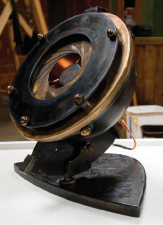
Two views of Rorie’s The Neuron Chamber and his Aperture Lamp. (Opposite) Rorie working on the StampMobile and The Uira Engine, which creates lightning, on display at the Sonoma County Museum.
